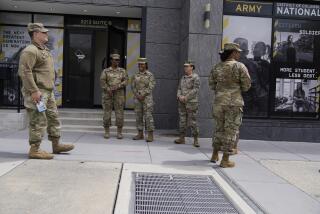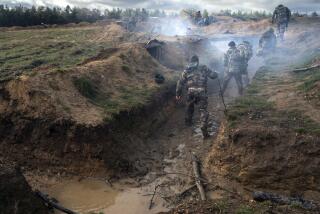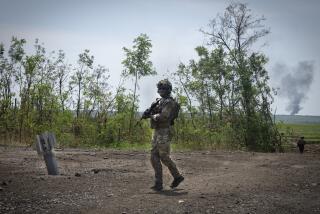Turning Into a Lean, Mean Fighting Machine : Military: A division sheds excess baggage to accommodate an influx of soldiers and weapons.
WITH U.S. FORCES, Saudi Arabia — Inching toward the border, this heavy Army division has begun to shed excess baggage while working to accommodate an influx of soldiers and weapons that have swelled maneuver units well beyond accustomed proportions.
The transition toward a fighting form has left some abandoned camps cluttered as ground troops cast off latrines, showers, tent poles and camouflage nets, trying to lighten their wartime load.
But, at the same time, the surge of new men and materiel has made battalions suddenly appear gawky, like teen-agers trying to regain their grace after a sudden growth spurt.
“We’re going to have to get used to the pace demanded by an uncooperative opponent,” Col. James C. Riley, commander of the 3rd Brigade, 3rd Infantry Division, said with some frustration the other day. “The things we’re going through now at a very deliberate pace are going to have to flow. And they’re going to have to flow at rates a lot faster than we’re doing it.
“It’s got to be click, click, click--real fast,” he said.
The metamorphosis, occurring as this armored division begins to hop from site to site, has caused some officers to shake their heads in wonder at the size of the units they now command. They also are looking to cast off whatever they can to streamline the force for combat.
The pre-combat adjustment is a particular test for this European-based unit, because the confined spaces of its German home left the division scattered from town-to-town, providing no training ground sufficient to permit large units to reunite and train at full combat strength.
At the same time, officers say, the division has grown accustomed to traveling comfort-heavy, with its training-exercise headquarters often set up in rented farmhouses and its supply lines, ever-flush with goods, hauled along well-paved highways.
“In Europe, you can go and take everything you want,” said Maj. Manny Alvarado, staff officer for administration in an infantry brigade, now attached to the 1st Armored Division. “Here, things are different. Here, you’ve got to move.”
Among the reinforcements the infantry and armor units are hurrying to get accustomed to are artillery, air defense and combat engineers. Their supporting roles, officers say, had in some cases been little more than plans on paper.
In an exercise this week, an infantry battalion teamed up with its new team of engineers to rehearse for the first time a barrier-breaching maneuver that could be crucial in an attack against well-fortified Iraqi defenders.
The unit’s commander, Lt. Col. Pat Egan, emphasized that he was not displeased with the maiden run and that he expected still more time to drill and hone the operation.
But for now, the battalion-sized assault had the look of dance among unfamiliar partners as the commander started and stopped the rehearsal, urging his team to “go over this minuet one more time.”
“Our Army hasn’t done this in years,” Egan said of the rusty coordination between his infantry and engineers. “This is like the first day of spring practice. I remember how to put on the pads, but after that, it’s learning the drills over again.”
The experience has been similar elsewhere in the desert, where some commanders worry that the enlarged ranks, for all their combat power, leave their force more unwieldy then they had hoped.
“We’ve had to reorder our thinking on how fast things can happen,” acknowledged Maj. Mark Curry, operations officer for this armored brigade.
To regain speed that had been lost, commanders in recent days have emphasized extensive test-maneuvers, hoping as Egan said “to get the bugs out” before any ground offensive begins. But many also hope to streamline by purging the baggage that an Army can collect but can be spared as divisions head closer to the front.
Advised to hang on only to “what you’ll need to fight a war,” commanders here are discarding latrines, mirrors, netting and tent poles and heaps of excess lumber as they move northward to ever-leaner camps.
“And when you get into battle, you take anything you’ve got left over and just push it off the tank’s back deck,” said Capt. Phil Theiler, a tank company commander in the 70th Armor Regiment. “The guys behind us are supposed to come along and pick it up.”
More to Read
Sign up for Essential California
The most important California stories and recommendations in your inbox every morning.
You may occasionally receive promotional content from the Los Angeles Times.









